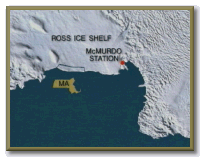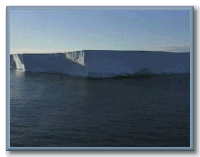Last season saw one of the largest icebergs ever break off the Ross Ice Shelf, near America's McMurdo station.
It was called "B-15"... 180 miles long, 22 miles wide, equivalent to the state of Massachusetts.
|
Image courtesy of the |
Image courtesy of the |
Satellites were able to track it from above... though sometimes even a giant berg got lost in thick, obscuring clouds. Researchers thought it was as much as 1300 feet deep.
In following months, the currents broke B-15 up into two huge chunks, one of which began to drift still closer to McMurdo. Both for safety and for science it was time to try to track the big bergs' movements very carefully.
|
|
|
Researchers decided to place sensors on the ice berg, to let them know precisely where it was, and the weather conditions. That's easier said than done. It required close coordination with the coast guard icebreaker, "Polar Sea." |
Image courtesy of the |
Image courtesy of the |
Safety first, as every where in the Antarctic. Mountaineers checked for cracks and crevasses. Then a Coast Guard helicopter placed the researchers and their instruments aboard the giant floating platform. They assembled an automated weather station (AWS) which they would leave on top of the berg, which towered 20 stories, 160 feet, above the ocean. There was an anemometer, solar panels to power it during Antarctic summer, and satellite links to send back data. |
|
|
|
|
|
WANT TO LEARN MORE?
|
|
Websites
• Images Available: Science Team Places Sensors on Enormous Iceberg to Track Motion, Weather Conditions Article on the placement of three weather stations on B-15 to track the iceberg's movements. |
![]()





